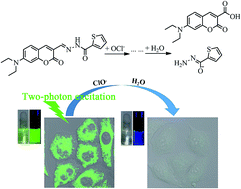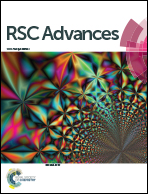A coumarin Schiff's base two-photon fluorescent probe for hypochlorite in living cells and zebrafish†
Abstract
Selective and sensitive fluorescent probes for ClO− are desirable due to the importance of ClO− in biological processes. Here, a coumarin Schiff's base, compound 1, has been developed and successfully used as a one- and two-photon fluorescent probe for ClO− with high selectivity. This probe can recognize ClO− with obvious color change from yellow-green to colorless and green to blue fluorescence emission, which can be observed by the naked eye. The properties of low cytotoxicity and good cell permeability allow it to be used for ClO− detection in living cells and zebrafish by both one- and two-photon microscopy imaging. All these results indicate that the compound is a sensitive probe with potential for analysis of ClO− in biological samples. The mechanism by which probe 1 recognizes ClO− is possibly nucleophilic addition followed by hydrolysis.



 Please wait while we load your content...
Please wait while we load your content...